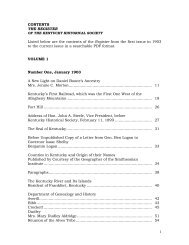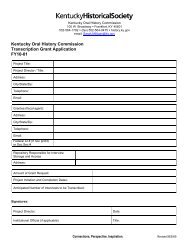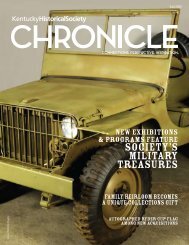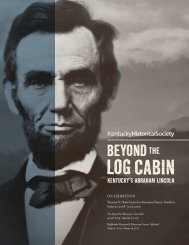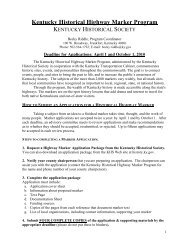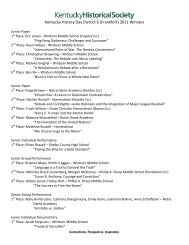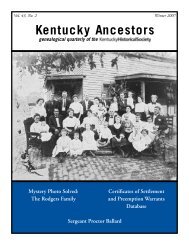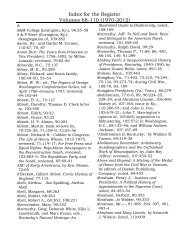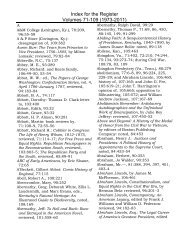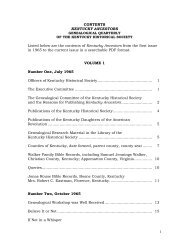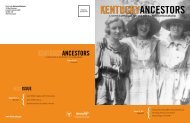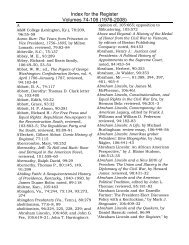Kentucky Ancestors, Volume 46, Number 2 - Kentucky Historical ...
Kentucky Ancestors, Volume 46, Number 2 - Kentucky Historical ...
Kentucky Ancestors, Volume 46, Number 2 - Kentucky Historical ...
You also want an ePaper? Increase the reach of your titles
YUMPU automatically turns print PDFs into web optimized ePapers that Google loves.
special skills in order to be successful. Constant<br />
vigilance was required because the clientele was<br />
transient, and in a riverboat town like Louisville,<br />
the chances for chicanery in business transactions<br />
were constantly present. In addition, Bustard had<br />
to deal with problems such as an inadequate supply<br />
of money in circulation, frequent bank failures,<br />
untrustworthy debtors, and thievery.<br />
The Bustard store mentioned in a court record,<br />
dated 7 August 1798, was located on the south side<br />
of Main Street between Fourth and Fifth streets.<br />
Other records show that Bustard resided at the same<br />
location which was designated “Lot 80.” Later he<br />
would acquire the adjoining lot and in May 1804,<br />
he bought half of lot number 83 for $700 from John<br />
and Abigail Speed, and William and Cynthia Pope.<br />
This purchase appears to have involved a settlement<br />
ordered by the Jefferson County Circuit Court.<br />
On 14 July 1804 he purchased part of lot No. 84<br />
from Adam and Betsey Steele for $200. 4 Slowly he<br />
acquired much of the frontage between Third and<br />
Fifth streets on the south side of Main Street. From<br />
an early date Bustard’s store, usually described as a<br />
general merchandising and dry goods store providing<br />
a large variety of goods for sale, had a reputation<br />
for business well beyond Louisville. <strong>Kentucky</strong>’s<br />
first newspaper, the <strong>Kentucky</strong> Gazette, published in<br />
Lexington, reported on 20 March 1804 that John<br />
Filson’s History of <strong>Kentucky</strong>, a book apparently in<br />
great demand, was available at a number of stores in<br />
the state, including “John Bustard’s in Louisville.” 5<br />
Beginning with its first issue, the Louisville Directory,<br />
a compilation of city businesses, continued each year<br />
to list Bustard’s store. Bustard owned and operated<br />
the store until his death in 1842.<br />
The minutes of the Jefferson County Court show<br />
that John Bustard from an early date accepted and<br />
performed his civic duties as a resident of Louisville.<br />
In 1805 he was appointed an assistant patroller “with<br />
full power to patrol at pleasure,” but the county court<br />
declared that he was to receive no compensation for<br />
helping to maintain order in the community. 6 With<br />
the increase of Ohio River traffic and the coming of<br />
steamboats on the river, the importance of the village<br />
of Shippingport, located adjacent to the Falls of the<br />
Ohio, took on greater importance. In January 1809<br />
the county court ordered John Bustard and three<br />
other citizens to “view and mark the best way for a<br />
public road from Louisville to Shippingport.” On<br />
68 | <strong>Kentucky</strong> <strong>Ancestors</strong><br />
a number of other occasions the court appointed<br />
Bustard to examine and settle the accounts of<br />
citizens in estate settlements. In other instances<br />
records show that he was asked by fellow citizens<br />
to officially witness important documents. Such<br />
activities as these indicated that Bustard was a person<br />
who could be trusted in fulfilling various civic duties<br />
and obligations and that he was recognized as an<br />
important citizen of the community. 7<br />
In 1806 the Bank of <strong>Kentucky</strong> was established<br />
by the state legislature. Eventually thirteen branch<br />
banks came into existence and Bustard was appointed<br />
cashier of the branch in Louisville and court records<br />
disclose that he later became a director of the<br />
bank. When economic conditions in the United<br />
States began to deteriorate due to inflation and the<br />
collapse of property values leading to the Panic of<br />
1819, Bustard’s connection with the bank forced his<br />
involvement in endless litigation. In the records of<br />
the Jefferson County Chancery Court, John Bustard<br />
is listed as defendant in eleven cases in 1819 alone<br />
and a total of thirty-six cases between 1818 and<br />
1834. He is listed as plaintiff in sixteen cases in the<br />
same period of time. 8 The economic difficulties led<br />
to a political struggle between those who wished<br />
to maintain established economic practices and<br />
those who sought replevin and stay laws as a form<br />
of relief. In <strong>Kentucky</strong> this struggle became known<br />
as the Old Court-New Court controversy and these<br />
circumstances resulted in Bustard defending the Bank<br />
of <strong>Kentucky</strong> in court cases while it was being forced<br />
out of business. The bank ceased its operation in<br />
1822, but the legal repercussions would drag on for<br />
more than a decade.<br />
One of the most interesting situations resulting<br />
from the economic downturn involved the<br />
bankruptcy of John Gwathmey who was a cashier<br />
of the Louisville branch of the Bank of <strong>Kentucky</strong><br />
as well as a commissioner for the city. Gwathmey<br />
built a large seventeen room house on Sixth Street,<br />
circa 1810, and owned several important businesses<br />
in Louisville. Among them were the Indian Queen<br />
Hotel, Union Tavern, a steamboat, and a factory<br />
that manufactured “bagging.” A newspaper notice<br />
in 1816 announced that the factory was hiring<br />
“fifteen men, thirty boys, and four women,” and<br />
that it would “pay cash for hemp.” 9 In spite of his<br />
business successes, Gwathmey accumulated numerous<br />
debts and over-extended his credit. Records of the





